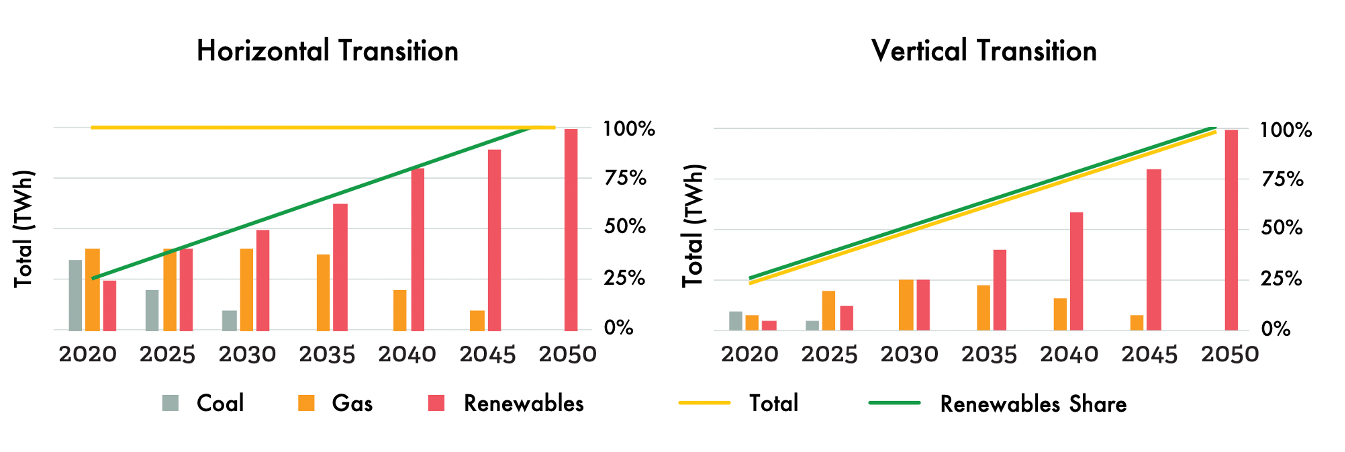Sub-Saharan Africa is home to all seven countries with electrification rates lower than 20%: Burkina Faso, Burundi, Chad, the Democratic Republic of Congo, Malawi, Niger, and South Sudan.1 Many others have basic electrification but fall far short of the Modern Energy Minimum needed to power job-creating enterprises.2 Concerns about climate change and rapidly declining costs of renewable energy sources like solar and wind have led to calls for low-income countries to “leapfrog” fossil fuels in their energy development pathways.3
What is a vertical energy transition?
The shift to renewable energy in countries facing rapidly growing electricity demand but starting from a low base threshold of energy infrastructure represents a “vertical transition” (Figure 1). Low-income countries must add large quantities of renewable energy while rapidly building out grid and distribution infrastructure, grid management capability, workable energy market regulations, and dispatchable capacity to back up intermittent sources like wind and solar.
For rich countries, by contrast, renewable energy development is a “horizontal transition.” These countries start with robust economies, mature electricity grids and markets, and ample generating capacity to meet demand, which is expected to remain relatively stable. Their challenge is to displace energy from large fossil fuel fleets with renewable sources as quickly as possible. Even so, ditching fossil fuels is not easy. Many of these countries have indicated an intention to build new fossil-fired generators to ensure adequate backup for solar and wind.4
Figure 1 illustrates horizontal and vertical energy transitions in a stylized manner. In the horizontal transition, a country’s total energy demand stays constant while its share of renewable energy grows linearly from 25% to 100%. In the vertical transition, a country’s total energy demand grows linearly at the same time as its renewable energy share grows linearly from 25% to 100%. A horizontal energy transition only requires phasing out legacy fossil fuel capacity as renewables grow, whereas a vertical transition requires building out additional capacity to back up renewables (assumed here to be gas-fired generators) in the near term before phasing it out long-term. A vertical transition without new dispatchable generation would imply a faster-than-linear increase in renewable energy share as well as the deployment of short-term and long-term energy storage on a scale far exceeding what has been achieved in rich countries.
FIGURE 1: Stylized depiction of a horizontal (left) versus vertical (right) transition

Challenges of a vertical energy transition
Countries pursuing vertical energy transitions need to build out wind and solar generation while simultaneously developing the capabilities to integrate variable renewable energy. These capabilities include:
- Dispatchable backup sources. Most rich countries use gas-fired generation to back up wind and solar, but infrastructure and market constraints have limited the use of natural gas in low-income countries thus far. Utility-scale energy storage can help in theory, but even in rich countries, cost remains a significant barrier.
- Transmission and distribution infrastructure. Extensive transmission networks are essential to bring electricity from wind and solar resources to population centers. Transmission allows wind and solar generation to be exported when in oversupply and backfilled when absent. If there is significant distributed solar on the grid, distribution networks need to be built and/or upgraded to handle bidirectional electricity flow.
- Grid management capability. When there is significant wind and solar, the grid operator must forecast weather as well as demand. As wind and solar output fluctuate, the grid operator must call on generators to rapidly ramp up and down to maintain transmission line voltage and system frequency. This requires automated generation control and other technical capabilities.
- Cost-recovering energy market framework. Many low-income countries struggle to recover costs in their electricity supply systems, which makes it difficult to invest in any of the technical and human capabilities needed to run a reliable, high-renewables grid. Governments must often try to make energy policy reforms while they “green” their grids.
Rich countries undergoing horizontal energy transitions already have most or all these prerequisites in place. They may also benefit from a more favorable political climate for the energy transition. Because the energy needs of their economies are already being met and unemployment rates are lower, climate change may be viewed as a more urgent priority by more citizens.
Limitations on leapfrogging
Because the energy transition in energy-poor countries is fundamentally different from that of wealthier countries, calls for technology leapfrogging must carefully consider where and when it is appropriate. For example, lower-income countries may be able to partially leapfrog legacy grid paradigms based on large fossil fuel power plants near cities. They are not likely to be able to leapfrog to a grid that is entirely powered by wind and solar plus energy storage — at least not while also expanding electricity access and driving economic growth.
Donors that sincerely want to help lower-income countries build out an energy supply system based on variable renewable energy need to recognize that vertical energy transitions require a different set of tools. Investments in wind and solar generation need to be matched with investments in dispatchable backup, transmission and distribution, and capacity building for grid operators.
Endnotes
- World Bank. (2020). SDG 7 Tracker https://trackingsdg7.esmap.org/.
- Moss et al (2021). Raising global energy ambitions: The Modern Energy Minimum. https://www.energyforgrowth.org/report/modern-energy-minimum/.
- UN. (2019). Secretary-General’s remarks at opening ceremony of UN Climate Change Conference COP25.
- For example, German Chancellor-in-waiting Olaf Scholz was categorical in the lead-up to COP 26 that Germany must invest in new gas-fired plants to maintain energy security while integrating high shares of renewable energy. (Reuters (2021).

